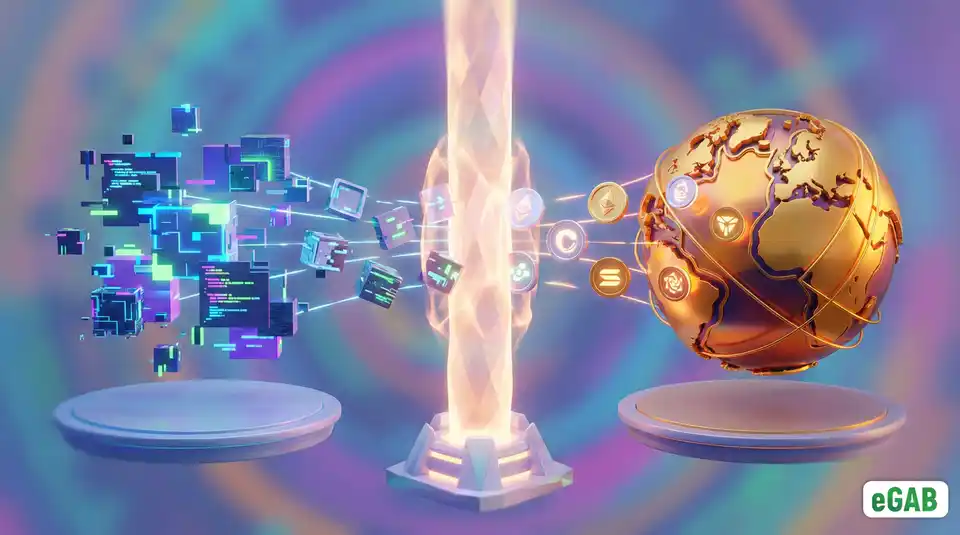The Role of TTP in the Global Recognition of NFT Credentials

 Author:
Artem Grigoriev
Author:
Artem Grigoriev
- How Do TTPs Bridge the Gap Between On-Chain Tokens and Real-World Authority?
- Why Are TTPs Essential for Creating Global Interoperability and Acceptance?
- What Is the TTP's Role in Managing the Credential Lifecycle and Ensuring Validity?
- How Do TTPs Secure Digital Credibility for Employers and Institutions?
- Summary: Why the TTP is the Essential Anchor for Digital Credential Trust
Have you ever wondered what really gives a digital degree its value? We're all seeing this huge push toward NFT credentials. But let's be honest. On its own, a token in a digital wallet is just a piece of code. So, what stops anyone from making a digital "fake"?
That's precisely where the Trusted Third Party (TTP) comes in. So, what is the role of TTP in digital credentials? Crucially, it acts as the essential, human-in-the-loop bridge. It's the "link" that connects that digital token to a real-world reputation. We're talking about the hard-earned reputation of an issuing institution (like a university).
Here's the key takeaway: The TTP provides the authority and trust. This is what's needed for the global recognition of NFT credentials . Think of it as the secret sauce. It transforms a simple file into a verifiable credential (VC). This is something employers and schools can actually rely on. Let's dive into how these TTPs build this trust. We'll also explore why they are the only real solution to the messy fragmented trust model . (That's a major problem we'll get to.) And we'll see how they manage the entire NFT credential lifecycle. This ensures your achievements are valid and respected anywhere in the world.
We are in the midst of a major push toward digital-first education, and as part of this shift, the concept of TTP for NFT credentials is becoming a critical topic. This leads to the obvious questions: But what is the role of TTP in digital credentials, and why does it matter so much? In short, it's all about trust. You see, as we move beyond traditional paper certificates, we're embracing new forms of verifiable credentials (VCs) that are specifically designed to build a secure, portable digital identity. Yet, there's a catch: for these new digital tokens to have any real-world value, they absolutely need global recognition of NFT credentials. And this, precisely, is where the trusted third party blockchain credentials model comes in, functioning by acting as the essential bridge between a digital token and its real-world authority.
⚖️ The concept of a Trusted Third Party is the legal and structural backbone of the entire Complete Guide to Digital Documents.
How Do TTPs Bridge the Gap Between On-Chain Tokens and Real-World Authority?
Let's be perfectly real and honest: an NFT credential, on its own, is just a sophisticated line of code. Ultimately, it’s a digital token. So, what gives it any actual power? Like the power to get you a job or to get you into a graduate program? That power doesn't come from the code itself; it comes entirely from the Trusted Third Party (TTP) that issues it. So, this begs the question: what is a Trusted Third Party (TTP) in blockchain? Simply put, it's the issuing institution -the university, the college, the professional body-that stakes its own hard-earned reputation on the validity of that specific token. Just think of an accredited university, for example. Their power and influence come from their official accreditation, which is a status built on decades (if not more) of academic rigor. Therefore, the TTP's most important job is to functionally link its established, real-world reputation directly to that digital token. This isn't trivial; we're talking about a reputation they have sometimes built over centuries.
But this is exactly where the wheels can fall off. Without careful planning, this process can very easily create a fragmented trust model (a system that splits trust among many different, unconnected platforms). This, right here, is the very definition of the fragmented trust model digital credentials problem. I mean, just imagine what happens if every single university decides to build its own "walled garden" system. In the industry, this is what we call a "Build" approach. What happens next? Suddenly, an employer needing to verify candidates is completely stuck. Why? Because they'd have to learn to trust and navigate hundreds of different, proprietary, and likely unvetted tech platforms. Simply put, it would be a nightmare.
Let's be clear: that model simply doesn't scale. Really, think about it. An employer might trust the institution (like a university, of course), but that doesn't mean they'll automatically trust its custom-built, in-house technology . This kind of fragmentation is the exact opposite of what the global economy needs. What does it need? It desperately needs a single, reliable source of truth. And this isn't just theory; in fact, a 2023 report from the verification service Verifile found something pretty alarming. In that report, it noted that a staggering 53% of organizations uncover discrepancies in candidate-provided qualifications. This finding is significant because it highlights just how broken the trust already is in our current systems. To be blunt, this isn't just about minor 'discrepancies'; it's about active credential fraud , and it's a massive problem that isolated systems are completely unequipped to fight.

Why Are TTPs Essential for Creating Global Interoperability and Acceptance?
And the challenge of recognition gets even bigger when you look at the global picture. The reason why? It's because educational standards are often trapped in silos; every country relies on different, incompatible systems for grading and accreditation. This challenge is so significant, in fact, that major international bodies are actively addressing it. Even giants like UNESCO are on it, working to resolve this through initiatives like the Global Convention on the Recognition of Qualifications concerning Higher Education . This is, without a doubt, a massive issue for the higher education sector worldwide. So, for digital credentials to be truly useful, a TTP framework needs to create a common set of standards. These digital credential standards are the essential bedrock of true global interoperability for digital credentials. This is the component that ensures global interoperability (the ability for different systems to work together and understand each other's data). But what does that mean in practice? It's actually quite simple. It's all about making sure a credential from one country is easily understood and trusted in another.
This, right here, is the critical failure point for so many systems. It’s a fundamental failure for both custom "Build" models and isolated "Buy" platforms. Why? Because by themselves, they simply can't create a globally accepted framework. They don't build bridges; they just create more digital islands .
The
only viable
solution, therefore, has to be a dedicated ecosystem. This ecosystem must be designed to
become
the TTP framework for everyone. And this is the precise role of the
eGAB (Global Academic Blockchain Ecosystem)
. Acting as the Global Digital Credentials Management Program,
eGAB
unites all its member institutions. It effectively brings them under a single, standardized, and globally trusted system. This is the critical move that transforms their credentials. As a result, they go from being isolated, locally-recognized tokens to becoming powerful assets that can be verified and trusted anywhere in the world.

What Is the TTP's Role in Managing the Credential Lifecycle and Ensuring Validity?
So, let's explore another key aspect: how do you manage the lifecycle of an NFT credential? This process, formally known as NFT credential lifecycle management, is a core TTP responsibility that is, unfortunately, often overlooked. To understand why, think about your own academic or professional records. They aren't just "set it and forget it," are they? Credentials expire, they get updated with new qualifications, and in some unfortunate but necessary cases, they can even be revoked. This naturally raises the crucial question: can NFT credentials be revoked or updated? The answer is: absolutely, and they must be. A TTP's job, therefore, isn't just to issue a credential and walk away. It has to actively manage this entire lifecycle. This active, ongoing management ensures the digital record is always valid and 100% up-to-date.
This, by the way, is a massive weakness for credentials issued on public blockchains. The reason why is simple: Those public systems were never designed from the ground up to handle the compliance , control, or revocation that a regulated institution (like a university) needs. And we're not the only ones saying this; the Digital Credentials Consortium (DCC) points this out, too. They explicitly note that the ability to revoke or update a credential (its 'status') is a core component. In fact, they state it's a non-negotiable part of any trustworthy digital identity system.
The
eGAB
ecosystem solves this problem directly. It does so by running on its own proprietary, centralized CREST Chain. This very distinction is the heart of the
public vs. private blockchain
debate for credentials. The key thing to remember is this:
CREST Chain
is indeed a blockchain, but it's one built
specifically
for the unique needs of education. This purposeful design gives institutions the fine-tuned control they need. It's the absolute control they must have to manage the full credential lifecycle. So, what this means in practice is that the digital record always reflects the real-world status, and it does so with 100% accuracy.

How Do TTPs Secure Digital Credibility for Employers and Institutions?
This brings us to the final, crucial step in the chain: digital credential verification . Logically, you might be asking, how do employers verify NFT credentials in a simple, reliable way? The answer is that when a unified TTP ecosystem works correctly, everyone wins. For employers, for example, a verification portal like credly.study is a complete game-changer. It provides a single, reliable, and cost-free place where they can instantly verify any credential from any member institution. This portal transparently handles all the complexity of verifying on-chain credentials for them. The benefit is clear: this immediately cuts through hiring friction, slashes the risk of fraud, and, ultimately, speeds up the entire onboarding process.
And for institutions, joining the
eGAB
ecosystem is also a very smart move. It’s simply the most secure and efficient way for you to protect your brand in the digital age. It allows you to completely bypass the immense cost and complexity of a "Build" solution. You also get to skip the significant security risks and the frustrating, long-term maintenance headaches that inevitably come with it.
So, what is the real difference between a "buy" vs. "build" TTP solution? Ultimately, the buy vs build credentialing system debate really comes down to this simple question: do you want to build a lonely, unproven tool, or do you want to join a trusted global network?
When you look at it that way, the
"Buy vs. Build"
choice becomes crystal clear. The
eGAB
"Buy" solution allows an institution to securely anchor its reputation in the digital world through a globally trusted partner. This, in turn, frees up the institution to focus on its core mission. And that mission is education, not blockchain development.
Why It Matters: A "Build" approach is, frankly, a huge risk. It forces an institution to stake its entire hard-won reputation on its own, unproven, in-house technology. A "Buy" approach, through a unified ecosystem like
eGAB, is fundamentally different. It allows an institution to stake its reputation not on its own tech, but on a globally recognized standard . This is, without question, a much safer and smarter bet for long-term credibility.

Summary: Why the TTP is the Essential Anchor for Digital Credential Trust
Okay, so what’s the real takeaway from all this? It is simple. The entire value of an NFT credential rests completely on the Trusted Third Party (TTP) . As we've explored, the digital token itself is just code. It is the issuing institution's established, real-world reputation. That is what actually gives it authority.
Here is the central challenge, though. If every institution creates its own "Build" system-its own "walled garden"-what happens? We inevitably end up with a hopelessly fragmented trust model . Just imagine the nightmare this creates for employers. They can't possibly navigate or trust hundreds of different platforms. This fragmentation also fails to fix a massive existing problem: credential fraud . (As the Verifile report showed, this unfortunately hits over half of all organizations.)
And this problem only gets worse when you look at it globally. Different national education systems create "digital islands." They have no global interoperability (the ability for different systems to work together). That is precisely why a unified ecosystem is the only viable solution. We need one that acts as a Global Digital Credentials Management Program . This is the "Buy" approach, which is embodied by eGAB. eGAB unites member institutions under a common set of standards. This creates the trusted framework. It allows a credential from one country to be instantly understood and verified in another. The result? True global recognition of NFT credentials .
What's more, the role of TTP in digital credentials goes far beyond just issuing them. It also includes a crucial, and often overlooked, responsibility. This is NFT credential lifecycle management (handling everything from creation to updates or revocation). Think about it. What happens if a credential needs to be updated, or even revoked? A TTP must maintain active control over that credential. This is a critical failure point for public blockchains. They simply lack the compliance and control features. These are features that institutions absolutely require. The eGAB ecosystem solves this problem. It uses its proprietary CREST Chain. This is a private blockchain built specifically for the education sector. What this means is that institutions get the power to manage the full lifecycle. They can ensure the digital record always matches the real-world status.
The bottom line is,
this unified TTP framework makes
digital credential verification
simple and reliable for everyone involved. For employers, a single portal like
credly.study
removes hiring friction. (That means delays in the hiring process.) It also removes the risk of fraud. It does this by providing one-click verification for any member. For institutions, joining this "Buy" ecosystem (like
eGAB
) is a far smarter choice. It's also much safer than a risky, go-it-alone "Build" solution. It allows them to anchor their reputation to a trusted global standard. This bypasses massive development costs and security risks. And, it lets them focus on their real mission: education.
🔍 Meet the Platform: You understand why a unified ecosystem is non-negotiable for trust. Now, examine the leading TTP platform designed to solve the fragmentation problem: Introducing TTP Credlystudy.

Marketing NFT Credentials: Efficiency Analysis, Research, and Experiments
FAQs on NFT Credentials in Education: Everything You Need to Know
Top Platform for Issuing NFT Credentials: Introducing TTP Credly.study
NFT and Blockchain in Education: All the Basics, Definition, and Explanation for Beginners
How NFTs Are Transforming Educational Credentials and Accreditation Processes
